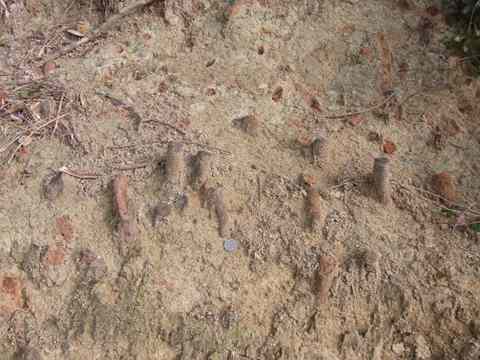Bushi
Bushi, Iruma city, Saitama pref., Japan
Occurrence
Sediments subjected to diagenesis
Trace fossils, Psilonichnus isp., replaced by siderite by diagenesis. This type of trace fossils has been considered as burrows made by Japanese mud shrimp (Upogebia major), but species can not be specified as it is known that most of species of genus Upogebia make same burrows. These trace fossils are in tuffaceous sandstone of the early Pleistocene Bushi Formation (1.8 Ma). The Bushi Formation is fluvial to shallow marine sediments, and overlies conformably the Hanno Conglomerate, the bottom member of the the Kazusa Group.

Outcrop of tuffaceous sandstone of the Bushi Formation. Tuffaceous sandstone is associated with tiny hornblende crystals. Cylindrical tubes sticking out are trace fossils, Psilonichnus isp. Burrows are filled by fine grains of pale brown siderite. There is a bed of lingite above this tuffaceous sandtone bed. Local people call this as Jyahun-seki "Snake's shit".
Reported Minerals
- Siderite
- Hornblende
- Pyrite
Mineral Assemblages
- Siderite - Pyrite
Localities
- Kanuma (Weathered pumice, Imogilite)
- Bushi (Trace fossil, Siderite)
- Kowada (Nodule, Siderite)
- Nohori (Trace fossil, Vivianite)
Related Occurrences
- Albite-Epidote-hornfels facies
- Hornblende-hornfels facies
- Pyroxene-hornfels facies
- Sanidinite-hornfels facies